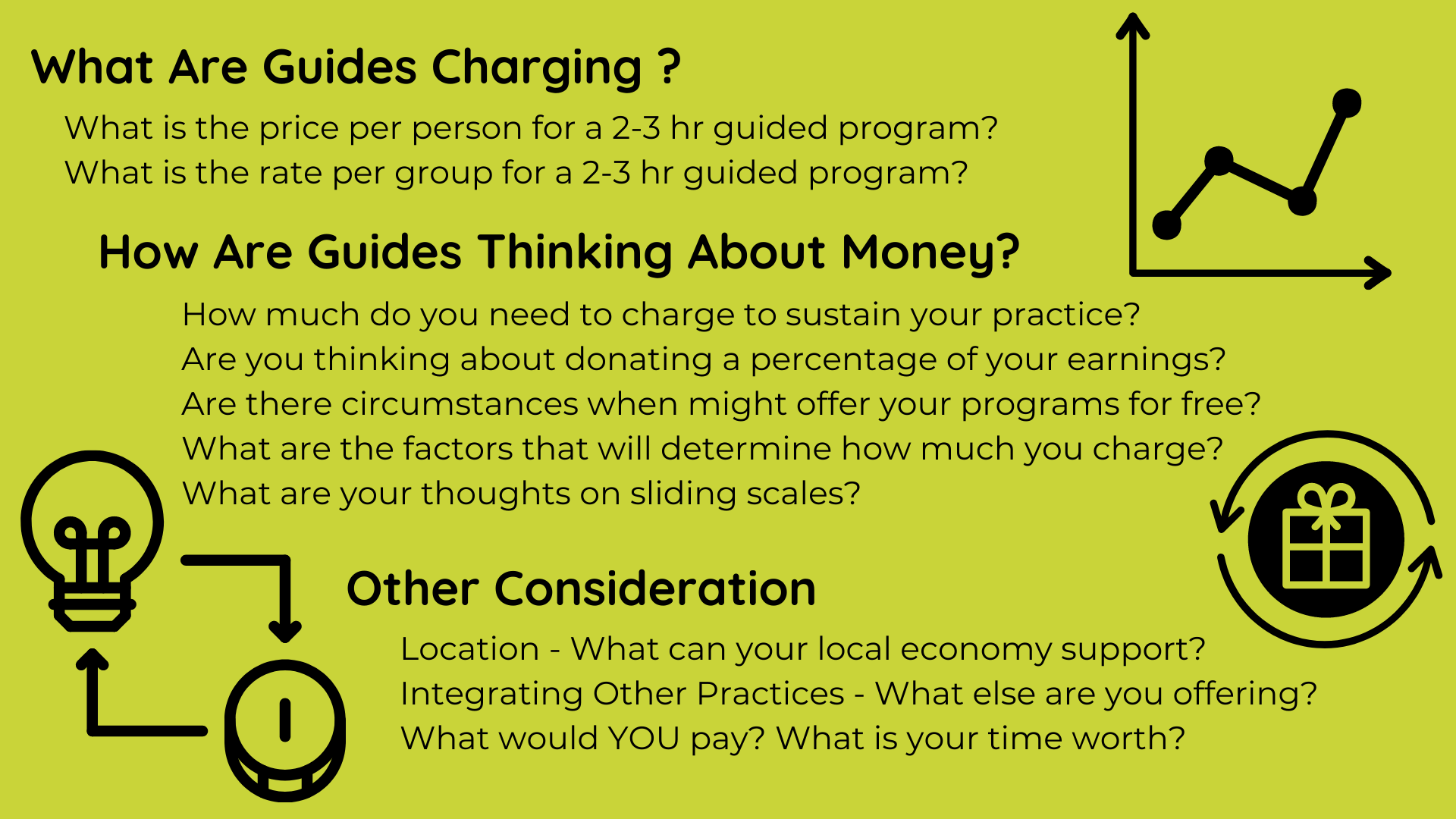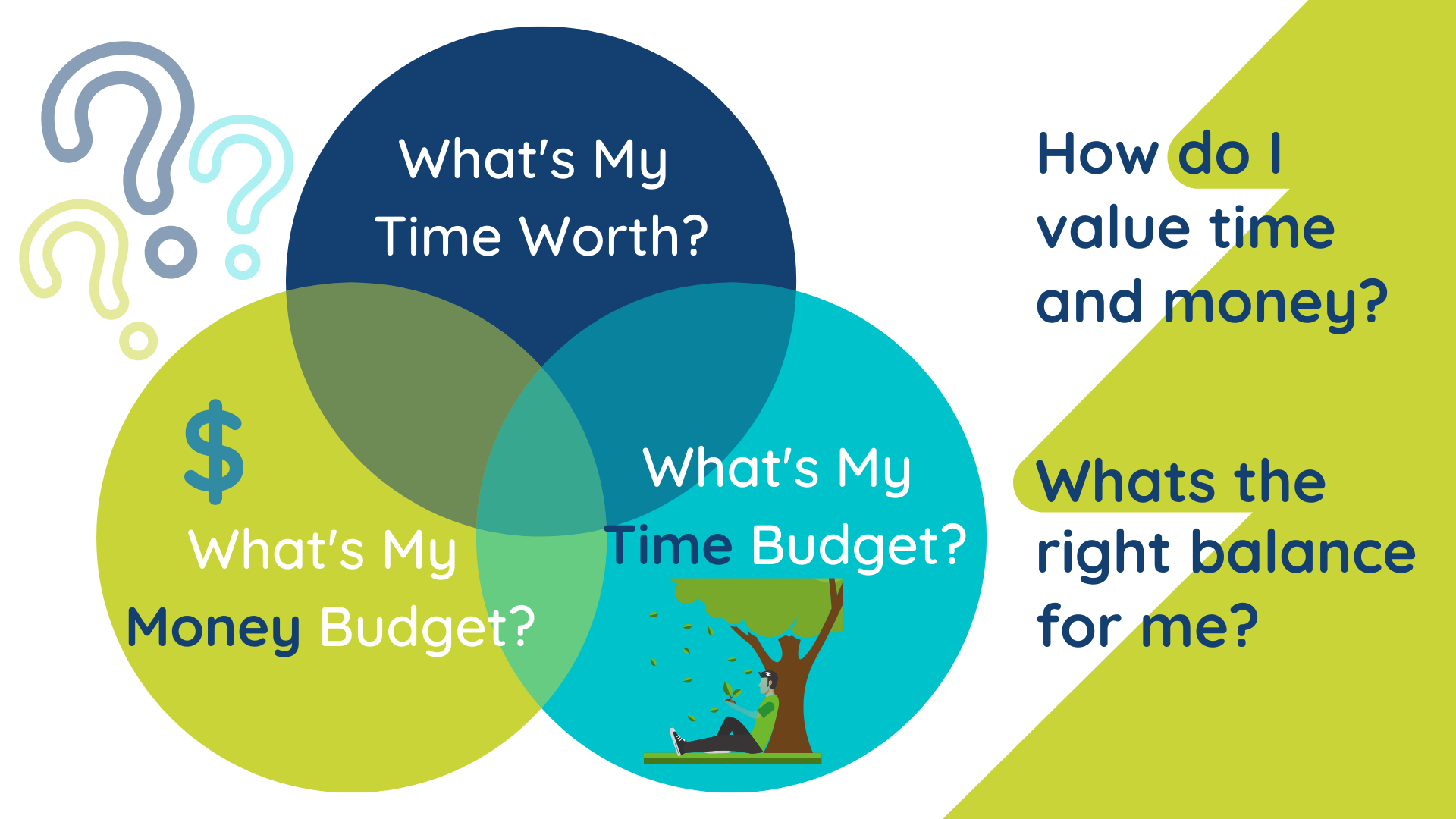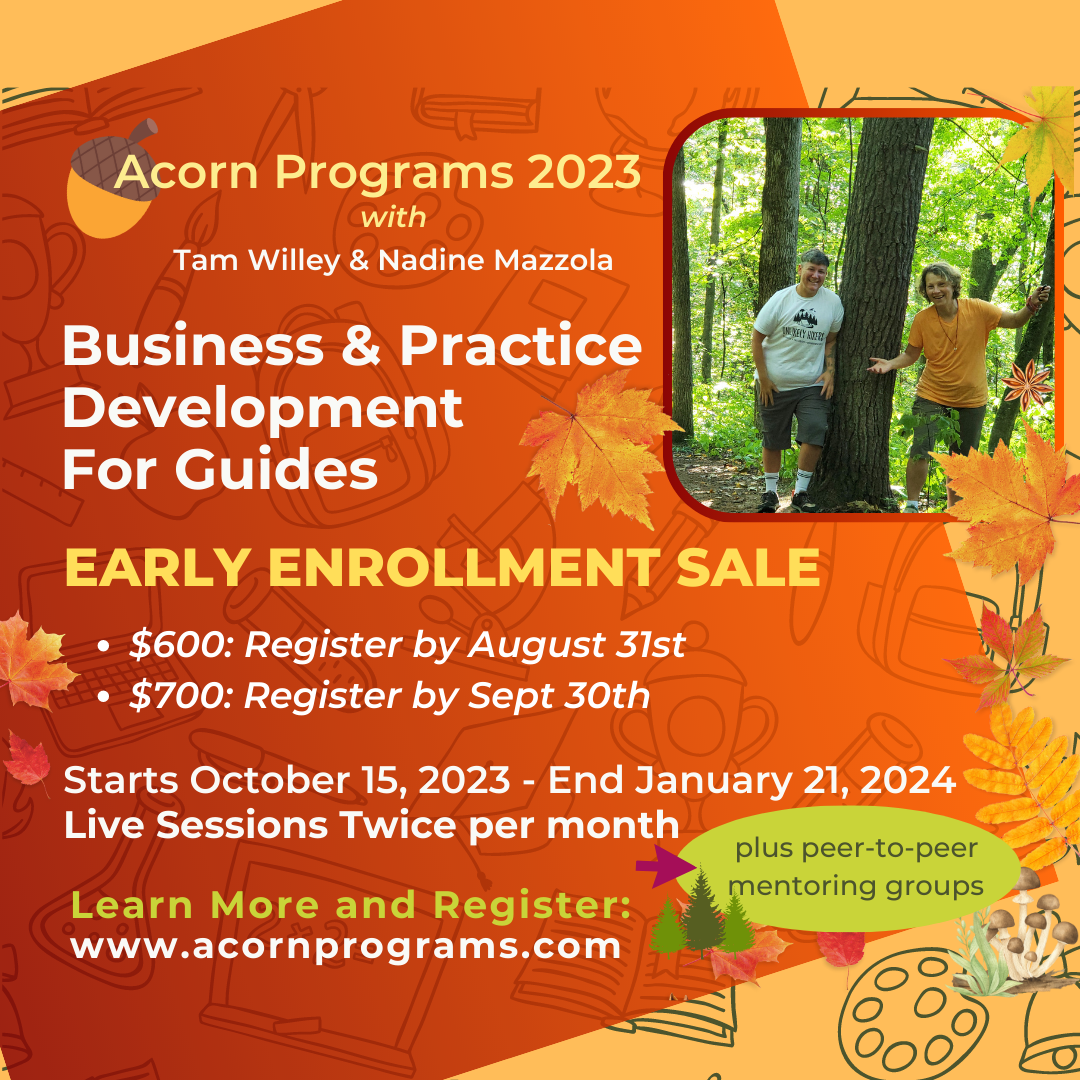2022 Guide Pricing Survey Results
Guides are often wondering what to charge for a few hours of guided programming. Given the many factors of each guide's unique circumstances, there is no one set price that can work across the industry of forest therapy, forest bathing, mindful outdoor guiding and other similar types of nature immersive programming. Pricing and charging is often a complex multi-layered process with many considerations that ask us to explore some reflective questions about our relationships with money and time along with other factors and historical considerations. How can we confidently charge for our services in a way that feels in aligned with our personal guiding practices and ways of being, regardless of what other guides are doing?
This survey is not intended to set any industry standards. The purpose is not to encourage or discourage guides from charging above or below any bar whatsoever. The aim to provide guides with some supportive information to help determine what will work for within the context of a guide's custom circumstances. This is a snap shot of the various factors that impact how guides are thinking about and considering their pricing structures.
The results below offer a very rough snapshot of some industry averages based on the experiences of 62 guides from various regions across the globe. Some of the places represented include Hong Kong, Brazil, Honolulu, London, New Zealand, Australia, across Canada, across the United States, and more. The represented geography includes a spectrum from financially thriving areas to struggling economies in rural, urban and suburban settings. All figures based in $USD.
This survey and the topic of money and charging is something we explore in great detail in the Acorn Business and Practice Development Program for Guides.
Learn More About Business and Practice Development for Guides


Negotiating payment terms when partnering with organizations
- Guides were fairly split down the middle when it came to negotiating flat rates vs. revenue percentage splits.
- Guides who agree to receiving a flat rate, often negotiated participant minimums.
- Guides who agree to a revenue split are taking 50% up to 90%, with most guides taking 70%-80%.
Guiding sponsored programs
- Some guides are being paid to guide programs that are free to the public.
- Guides who have been sponsored or paid to guide free-to-the-public programming, reported that these programs took place 1-5 times per year on average.
- Guides noted that free programming often fills quickly with a waiting list so the interest is there.
- Guides noted that when their programs were free to attend, about half of registered participants did not show nor did they communicate that they would not be in attendance.
What guides are successfully charging for a 2-3 hour program for a group of about 8-12 people
- A little over half of the guides surveyed are successfully charging $200-$350 per program
- A quarter of the guides surveyed are successfully charging upwards of $400-$700 per program
- A quarter of the guides surveyed are successfully charging upwards of $50-$150 per program
- Many guides are willing to work within the context of an organization's budget when partnering.
- Many guides have different rates for corporate vs nonprofit vs community programming.
- Many guides calculated their overhead budgets into the pricing, including anything and everything from website fees, training fees, travel fees, and gear.
- Some guides do not charge at all.
- Some guides offer a sliding scale with mixed results and varied definitions (example pay what you can vs pay what you want vs pay what you think this is worth)
What participants are paying to be guided on a 2-3 hour program
- The majority of participants are paying $20-$40 to attend a guided program
- Some participants are paying $50-$80 to attend a guided program
- Few participants are paying less than $20 to attend a guided program
- Some guides charge higher rates for individual private one on one programs
- Some guides base their per-person rates on what they like to make per hour
- Some guides acknowledged that they put in many hours of work beyond guiding the live program and took into account the preparation time including communications and the follow up emails, invoicing and bookkeeping
- Some guides acknowledged that they prefer to charge all groups a flat-fee rather than a per-person rate as the preparation time was the same regardless
- Some guides acknowledged that their local economy can not support what they would like to charge
- Some guides do not charge at all.
- Some guides offer a sliding scale with mixed results and varied definitions (example pay what you can vs pay what you want vs pay what you think this is worth)
Pricing other kinds of programming (such as talks, presentations, day-long programs, multi-day retreats, ongoing series, etc)
- Some guides offer a full day of programming for $500-$1200 per day
- Many guides will give a presentation for free for the publicity that it can often generate
- Some guides charge $300-$500 for a presentation
- Many guides offer an hourly rate for their time whether that be for one-to-one mentoring sessions or guiding, charging in the range of $75-$100 per hour
Guides share other considerations about their pricing structures
-
Most guides reported that they do not make a living solely from their guiding business
- Pricing is a constant work in progress with yearly re-evaluating
- Many guides want to be reimbursed for their time and energy and charge in a way that insures a minimum
- Many guides shared that they want to charge more than they were.
- Some guides do not feel comfortable charging at all or are in a position where they do not need to charge
- Guides who work in tourist areas are successfully charging much higher rates while some guides struggle to get participants to pay lower rates
- Some guides feel strongly that charging slightly higher than what feels comfortable, demonstrates value.
- Some guides do not publish their prices on their websites so that they can customize them on a case by case basis
- Some guides donate a percentage of their proceeds to various organizations that preserve land, plant trees, or support native land tenders
What this helpful? Want to explore more?
Leaning into questions around money is something we explore in great detail in the Acorn Business and Practice Development Program for Guides with worksheets, discussions and guided brainstorming sessions, and expert accounting guidance from fellow guide and certified public accountant (CPA) who recently offered a live session on bookkeeping, business structures, and tax considerations.
Our program is currently on sale. Live sessions begin this fall!
Learn More About Business and Practice Development for Guides

Join one of our programs
Exploring Registration Systems (Replay)
Watch the Replay -
Explore ways to make your sign-up process run easy and smooth, while finding an efficient method of communication with your registered participants. Find a system that works for you by going over step by step considerations of all the aspects of a registration process.
Business and Practice Development: Planning and creating your guiding practice.
A nature-based approach to marketing, uniquely designed for trained guides who are interested in building their guiding practice, via instructor-led live group-mentoring sessions and permanent access to an extensive online course.
SELF DIRECTED version of Business and Practice Development Course
Access to our extensive online resource library and forum without instructor-led live group-mentoring sessions. Uniquely designed for trained guides who are interested in building their guiding practice.
xxx
